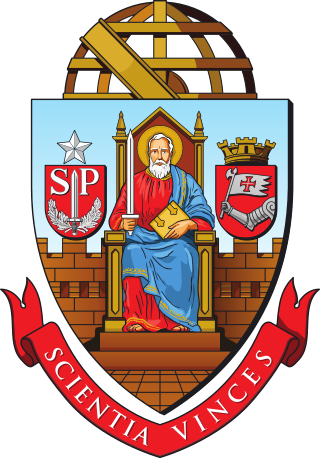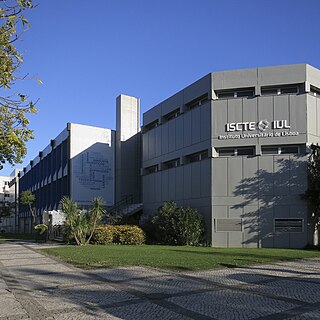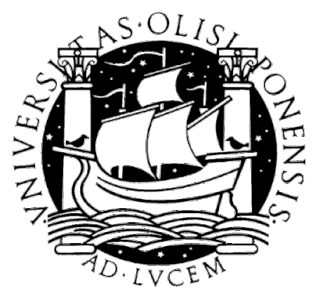
The University of São Paulo is a public research university in the Brazilian state of São Paulo, and the largest public university in Brazil. Since its founding, the university has maintained its status as the country's most prestigious educational institution.

The University of Coimbra is a public research university in Coimbra, Portugal. First established in Lisbon in 1290, it went through a number of relocations until moving permanently to Coimbra in 1537. The university is among the oldest universities in continuous operation in the world, the oldest in Portugal, and played an influential role in the development of higher education in the Portuguese-speaking world. In 2013, UNESCO declared the university a World Heritage Site, noting its architecture, unique culture and traditions, and historical role.

The Federal University of Rio Grande do Sul is a Brazilian public federal research university based in Porto Alegre, Rio Grande do Sul. UFRGS is among the largest and highest-rated universities in Brazil, having one of the largest number of scientific publications. From 2012 to 2019, the university was elected as the best federal university of Brazil. UFRGS has over 31,000 undergraduate students, over 12,000 graduate students, and more than 2,600 faculty members. As a Brazilian public federal institution, students do not pay tuition fees to enroll in courses offered by the university.

The Instituto Superior Técnico is the school of engineering and technology of the University of Lisbon. It was founded as an autonomous school in 1911, and was integrated into the Technical University of Lisbon in 1930. IST is the largest school of engineering in Portugal by number of enrolled students, faculty size, scientific production and patents.

NOVA University Lisbon, or just NOVA, is a Portuguese public university whose rectorate is located in Campolide, Lisbon. Founded in 1973, it is the newest of the public universities in the Portuguese capital city, earning its name as the "New" (NOVA) University of Lisbon.

The Technical University of Lisbon was a Portuguese public university. It was created in 1930 in Lisbon, as a confederation of preexisting schools, and comprised the faculties and institutes of veterinary medicine; agricultural sciences; economics and business administration; engineering, social and political sciences; architecture; and human kinetics.

São Paulo State University is a public university run by the state government of São Paulo, Brazil.
Higher education in Portugal is divided into two main subsystems: university and polytechnic education. It is provided in autonomous public and private universities, university institutes, polytechnic institutes and higher education institutions of other types.

The Instituto de Medicina Molecular João Lobo Antunes, or iMM for short, is an associated research institution of the University of Lisbon, in Lisbon, Portugal.

The University of Cape Verde is the only public university of Cape Verde. The main campus is in Palmarejo, Praia, but there are also institutes in Mindelo, Assomada and São Jorge dos Órgãos. It has over 5000 students. A new campus for Uni-CV is under construction in Palmarejo, financed by the Chinese government. It should be completed by July 2020. It will have capacity for 4,890 students and 476 professors, with a library, dorms, cafeterias and sports facilities. It will have 61 class rooms, five auditoriums with a capacity of 150 seats, eight computer rooms, eight reading rooms and 34 laboratories.
Anselmo Fernandez Rodrigues was a Portuguese architect and football manager who led Sporting Clube de Portugal to victory in the UEFA Cup Winners' Cup in 1964 and was the architect of Sporting CP's Estádio José Alvalade inaugurated in 1956.

ISCTE – Instituto Universitário de Lisboa is a Portuguese public tertiary education institution. It is located in the city centre of Lisbon, in Cidade Universitária, adjoining the Institute of Social Sciences (ICS) and Institute of Geography and Spatial Planning (IGOT) of the University of Lisbon. ISCTE was founded in 1972, starting with three degrees and 296 studentes. Formerly called Instituto Superior de Ciências do Trabalho e da Empresa, its full name was dropped in 2009 when it became a university institute of foundational nature.
The Centro de Avaliação de Português Língua Estrangeira (CAPLE), or Centre for Evaluation of Portuguese as a Foreign Language, issues certifications of proficiency in standard European Portuguese as a second language. CAPLE exams are offered in Portugal and 45 other countries and territories. The official CAPLE examinations and certificates/diplomas are developed, delivered, and accredited by a tri-partite collaboration in Portugal between the School of Arts and Humanities at the University of Lisbon and the Instituto Camões, which administers the examination procedures on behalf of the Portuguese Ministry of Foreign Affairs.
The University of Porto is a Portuguese public research university located in Porto, and founded on 22 March 1911. It is the second largest Portuguese university by number of enrolled students, after the University of Lisbon, and has one of the most noted research outputs in Portugal.

The University of Lisbon was a public university in Lisbon, Portugal. It was founded in 1911 after the fall of the Portuguese monarchy and was later integrated in the new University of Lisbon along with the former Technical University of Lisbon.

The University of Minho is a public university in Minho Province, Portugal. It is divided into the following campuses:
The Instituto Superior de Ciências Sociais e Políticas (ISCSP) is part of the University of Lisbon (ULisboa). It was known in the early 20th century as the Colonial School, when it was run by the Geographical Society of Lisbon. In 2016, ISCSP celebrated 110 years of continuous operation. As a higher education institution, ISCSP aims to equip students with skills in the cultural, scientific and technical fields; conduct fundamental and applied research; provide community service; and promote exchanges in the social and political sciences.
GASTagus, also known as Grupo de Ação Social do Tagus, is a Portuguese non-governmental development organization (NGDO).

The Faculty of Pharmacy, Universidade de Lisboa (FFUL) is a Portuguese public institution of higher education dedicated to education, research, knowledge transfer and continuing education in the fields of pharmacy, medicine, and pharmaceutical sciences.

The Sociedade Propagadora dos Conhecimentos Úteis of Lisbon, Portugal, formed in 1837. The group produced a weekly illustrated magazine, O Panorama, intended for the general interest reader and priced relatively affordably. According to the society, some copies were also distributed free of charge to charities such as Casa Pia orphanage and Casa de Expostos. Editors included Alexandre Herculano, António Feliciano de Castilho, and António de Oliveira Marreca. Other contributors included Rodrigo Jose de Lima Felner.




















